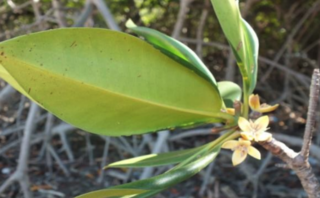
Ficus microcarpa, also known as Chinese banyan, small-fruited fig, Malayan banyan, Indian laurel, or curtain fig, is a species of banyan tree in the family Moraceae. Its native range is from India to China and Japan, through Southeast Asia and the western Pacific to the state of Queensland in Australia, and it has been introduced to parts of the Americas and the Mediterranean. It was first described in 1782, and is a culturally significant plant in a number of Asian countries.

Avicennia marina, commonly known as grey mangrove or white mangrove, is a species of mangrove tree classified in the plant family Acanthaceae. As with other mangroves, it occurs in the intertidal zones of estuarine areas.

Rhizophora is a genus of tropical mangrove trees, sometimes collectively called true mangroves. The most notable species is the red mangrove but some other species and a few natural hybrids are known. Rhizophora species generally live in intertidal zones which are inundated daily by the ocean. They exhibit a number of adaptations to this environment, including pneumatophores that elevate the plants above the water and allow them to respire oxygen even while their lower roots are submerged and a cytological molecular "pump" mechanism that allows them to remove excess salts from their cells. The generic name is derived from the Greek words ριζα (rhiza), meaning "root," and φορος (phoros), meaning "bearing," referring to the stilt-roots.

Heritiera littoralis, commonly known as the looking-glass mangrove or tulip mangrove, is a mangrove tree in the family Malvaceae native to coastal areas of eastern Africa, Asia, Melanesia and northern Australia. The common name refers to the silvery appearance of the underside of the leaves, resembling a mirror to some degree. The strong timber has uses in marine applications and elsewhere.

Cratoxylum maingayi is a flowering tree in the family Hypericaceae. The species is harvested for derum timber for limited local use.

Anisoptera costata is an endangered species of plant in the family Dipterocarpaceae. The specific epithet costata means "ribbed", referring to the prominent venation of the leaf blade. A huge emergent tree up to 65 m high, it is found in evergreen and semi-evergreen lowland tropical seasonal forests of Indo-Burma and in mixed dipterocarp forests of Malesia.

The tall-stilt mangrove belongs to the Plantae kingdom under the Rhizophoraceae family. R. apiculata is distributed throughout Southeast Asia and the western Pacific islands.

Bismarckia is a monotypic genus of flowering plant in the palm family with Bismarckia nobilis being the only species in the genus and is endemic to western and northern Madagascar, where it grows in open grassland.

Kandelia candel is a species of mangrove in the family Rhizophoraceae, found around the coasts of South Asia and Southeast Asia, from western India to Borneo. Populations further east, from Vietnam to Japan were formerly included in K. candel, but are now considered a separate species, K. obovata.
Rhizophora × lamarckii is a hybrid of Rhizophora apiculata and Rhizophora stylosa. Found in the Indo-West Pacific region within the Indomalaya biome in the Sunda Shelf mangroves ecoregion, the hybrid is widespread and shares many characters of its parents.

Dillenia suffruticosa, also known as simpoh air, simpor, or CB leaf, is a species of Dillenia found in tropical South East Asia in secondary forest and swampy ground. It is a highly invasive weed in Sri Lanka.

Allophylus cobbe, commonly known as titberry or Indian allophylus, is a pantropical, shrub in the family Sapindaceae with many uses in traditional medicine. It has a highly variable morphology throughout its range and may prove to be more than one species.

Sonneratia caseolaris, commonly known as mangrove apple, is a species of plant in the family Lythraceae. The fruit is noted for its outward similarity to the persimmon fruit.

Rhizophora mucronata is a species of mangrove found on coasts and river banks in East Africa and the Indo-Pacific region.

Ceriops tagal, commonly known as spurred mangrove or Indian mangrove, is a mangrove tree species in the family Rhizophoraceae. It is a protected tree in South Africa. The specific epithet tagal is a plant name from the Tagalog language.
Barringtonia conoidea is a plant in the family Lecythidaceae.

Bruguiera parviflora is a tree in the family Rhizophoraceae. The specific epithet parviflora is from the Latin meaning 'small flowers'.

Kandelia is a plant genus of two species in the mangrove family Rhizophoraceae.

Sonneratia alba is a mangrove tree in the family Lythraceae. The specific epithet alba is from the Latin meaning 'white', referring to the flowers.

Ceriops decandra is a mangrove plant of tropical Asia in the family Rhizophoraceae. The specific epithet decandra is from the Greek meaning 'ten male', referring to the flower having ten stamens.




















